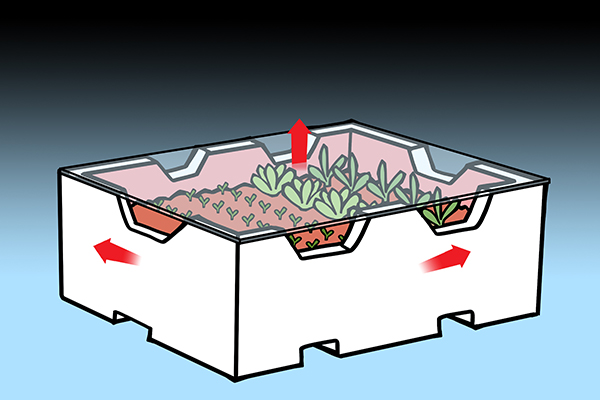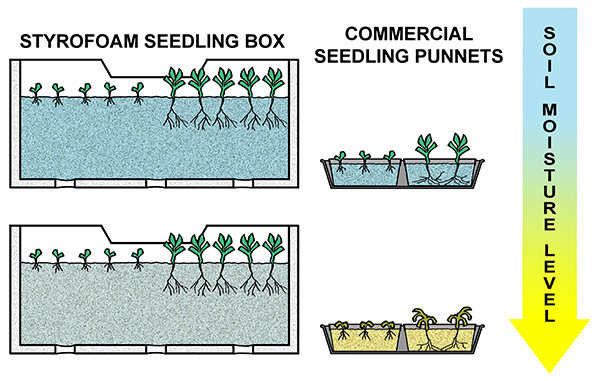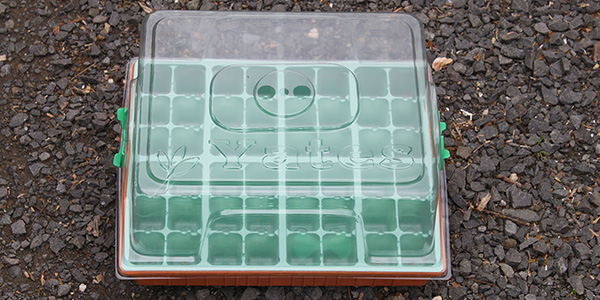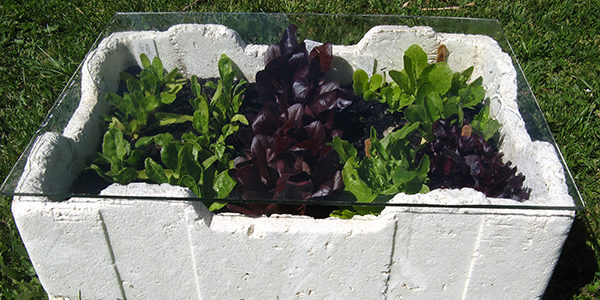The easiest way for home gardeners to produce their own seedlings is to grow them in a Styrofoam seedling propagation box.
ADVANTAGES
- GOOD MOISTURE RETENTION
Seedlings in Styrofoam seedling boxes are grown on a base of several litres in volume of compost or garden soil, which means that when you water your seedlings the soil base below acts as a sponge and absorbs water for your seedlings to draw upon. This means that you do not have to water as often and there is a much greater margin of error should you forget to water your seedlings, whereas commercial seedling punnets can dry out in less than a day, even in relatively mild conditions. - LOWER RISK OF OVERHEATING
The undulating top of the Styrofoam box means that when a pane of glass is placed on top of it there are plenty of side vent holes for excess heat to escape. If you unexpectedly strike a hot day and you have not removed the glass top, then the seedlings are unlikely to overheat as the excess heat easily vents out these side holes. Overheating will damage or even kill seedlings in a short space of time.
- KEEPS THE SEEDLINGS WARMER AT NIGHT
Because Styrofoam has good insulating properties and there is plenty of mass in the form of the soil/compost base Styrofoam propagation boxes retain more heat at night than commercial seedling punnets. This means that your seedlings will grow quicker and seeds that need higher soil temperatures, such as eggplant, basil and capsicum are more likely to survive. - INEXPENSIVE TO MAKE
A Styrofoam propagation box costs little to make. The boxes themselves can usually be picked up at supermarkets or green grocers for nothing and if you have some second-hand glass all you will need to buy is a glass cutter. Otherwise a sheet of glass can be bought from a glazier for around $15 AUD (2020 prices). By contrast commercial propagation boxes for sell around $30 AUD and only hold half the number of seedlings that a Styrofoam seedling box can hold.
DURABLE
If you do not break your glass a Styrofoam seedling box lid will last for years, whereas the plastic top on a commercial propagation box usually becomes brittle and cracks after four or five years.

The insulating properties of styrofoam and the larger soil mass keeps the seedlings warmer at night.

The wide vents allow excess heat to escape easily during daytime.

Commercial seedling boxes dry out more quickly than Styrofoam seedling boxes.
DISADVANTAGES
- CANNOT BE HEATED USING ARTIFICIAL HEATING
The size and insulating properties of Styrofoam boxes means you cannot place them on an electrically heated propagation tray. - SOIL OR COMPOST USED IN THE BASE OF THE BOX IS NOT STERILE
While the seeds are germinated in a surface layer of sterilised seed raising or potting mix the base is made up of garden soil or compost which is not sterilised. Any weed seeds in your compost or garden soil base are likely to also germinate. Soil that is not sterilised can also harbour fungal disease. Whereas commercial seedling punnets are small enough that you can fill them entirely with a sterilised seed raising mix. Though it is possible to fill a Styrofoam seedling box just with seed raising mix the cost would be prohibitive.
ADVANTAGES SUMMARY
ADVANTAGES
- GOOD MOISTURE RETENTION
- LOWER RISK OF OVERHEATING
- KEEPS THE SEEDLINGS WARMER AT NIGHT
- INEXPENSIVE TO MAKE
-
DURABLE
DISADVANTAGES SUMMARY
DISADVANTAGES
- CANNOT BE HEATED USING ARTIFICIAL HEATING
-
SOIL OR COMPOST USED IN THE BASE OF THE BOX IS NOT STERILE




